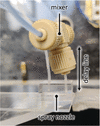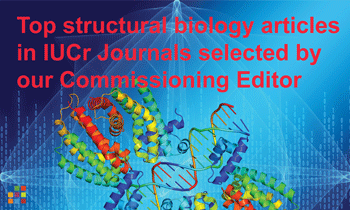issue contents
October 2021 issue

Cover illustration: Crystal structure of a dodecameric multicopper oxidase from Marinithermus hydrothermalis [Paavola et al. (2021), Acta Cryst. D77, 1336–1345]. MhMCO is shown binding divalent metal ions. The dodecamer from the orthorhombic structure is shown as a cartoon rendering with bound Ca2+ ions shown as red spheres and bound copper ions shown as blue spheres. In this view, 14 of 17 Ca2+ ions are shown along with 12 copper ions. A Ca2+ ion from each subunit is sequestered in the central portion of the dodecamer. Trp351, which exhibits two conformations in the structure and is located between copper ions bound to adjacent subunits, is shown as a green stick rendering.
scientific commentaries
Open  access
access
 access
accessA commentary on the article by Luchinat et al. [(2021), Acta Cryst. D77, 1247–1258] where they describe an approach to identify the details of a compound binding to a molecular target using in-cell NMR to provide intracellular binding affinities.
CCP-EM
Open  access
access
 access
accessThis review summarizes the best characterized and most relevant photocaging groups for time-resolved structural biology described in the literature to date. It provides a walkthrough of the essential factors to consider in designing a suitable photocaged molecule to address specific biological questions using time-resolved X-ray diffraction or solution-scattering methods.
Open  access
access
 access
accessTime-resolved cryo-EM allows the study of proteins under non-equilibrium conditions on the millisecond timescale. Here, in-flow and on-grid mixing techniques are directly compared and it is found that on-grid reactions can be influenced by air–water interactions, whilst in-flow reactions give a broader distribution of reaction times due to laminar flow.
CCP4
Open  access
access
 access
accesseSPC is an online tool to analyze biophysical data from fluorescence, microscale thermophoresis and differential scanning fluorimetry experiments. The modules from the data-analysis platform contain classical thermodynamic models and clear user guidelines for the determination of dissociation constants (Kd) and thermal unfolding parameters such as melting temperatures (Tm).
Open  access
access
 access
accessNeutron protein crystallography provides insight into the structure and reaction mechanism of transition-state metal oxidoreductases without resulting in radiation-damage-induced artefacts.
Open  access
access
 access
accessIntracellular protein–ligand dissociation constants are measured by in-cell NMR spectroscopy by means of competition binding experiments with respect to a reference ligand. The method is applied to a set of carbonic anhydrase inhibitors, revealing intracellular binding with nanomolar affinity.
Open  access
access
 access
accessA new program, Servalcat, to facilitate atomic model refinement in cryo-EM single-particle analysis is presented. It implements a refinement pipeline using REFMAC5 and Fo − Fc map calculation.
research papers
Embedded within the MoProViewer program, a new code library, Charger, contains an implementation of the analytical computation of the electrostatic interaction energy based on the multipolar atom. It was used to investigate the electrostatic interaction energies of benchmark dimers and glutathione transferase–benzophenone complexes.
Structure and mechanism of the γ-glutamyl-γ-aminobutyrate hydrolase SpuA from Pseudomonas aeruginosa
This article reports the structure and mechanism of SpuA, a class I glutamine amidotransferase from P. aeruginosa that forms part of a polyamine-utilization pathway.
Open  access
access
 access
accessThe homospermidine synthases from P. aeruginosa and B. viridis, as well as their single-residue variants, are compared based on crystal structures and activity assays. A high structural similarity is demonstrated, suggesting the equivalent involvement of relevant residues in the reaction mechanism and catalytic dependence on cation–π interaction.
PDB references: homospermidine synthase from Blastochloris viridis, W229E variant, complex with NAD, 6sep; E210Q variant, complex with NAD, 6s3x; W229F variant, complex with NAD, 6s4d; E210A variant, complex with NAD, 6s49; E117Q variant, complex with NAD, 6s6g; W229A variant, complex with NAD and PUT, 6s72; from Pseudomonas aeruginosa, complex with NAD and PUT, 6y87
A two-domain multicopper oxidase (MCO) from Marinithermus hydrothermalis functions as a laccase and was crystallized in two distinct lattices as a dodecameric ball-like structure. Crystal structures are reported in cubic and orthorhombic lattices at 1.92 and 2.36 Å resolution, respectively. This MCO forms trimers similar to those found in other two-domain MCOs, but is unique in forming a higher order dodecameric structure.


 journal menu
journal menu





























